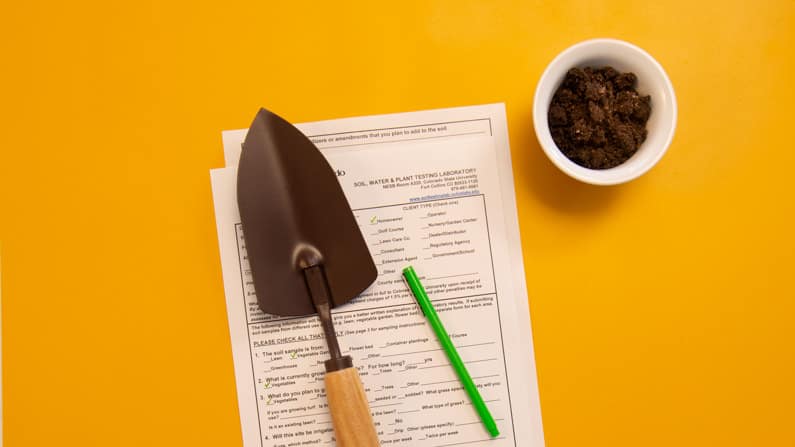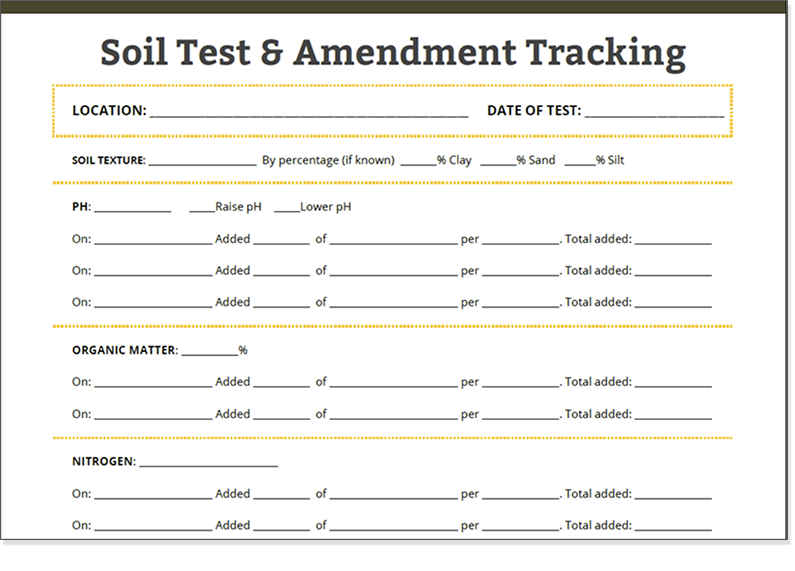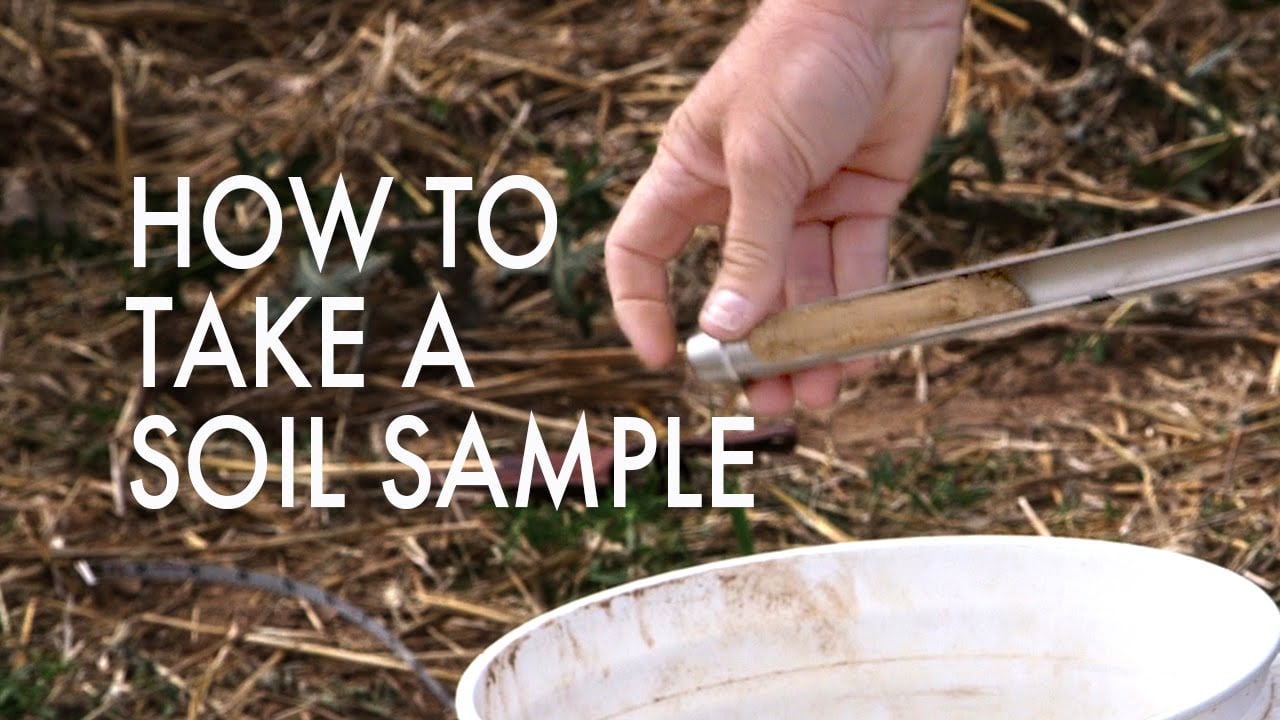How to Test Soil Like an Expert
Garden soil seems mysterious, doesn’t it?
It never hops up says, “hey, I’ve got a problem!”
No, it just sits there waiting for you to figure out why your tomatoes have blight, your grass isn’t as green as you’d like, or your hydrangeas aren’t periwinkle blue like the ones you’ve been drooling over on Pinterest.
But we’re going to take the mystery out of soil science.
Learning how your soil affects your plants will give you a huge advantage. You’ll dramatically increase your odds of being a successful gardener, by like 80%!
What?! 80%?
Sound too good to be true?
Well … most garden problems can be traced back to poor nutrition for your plants.
Plants need food to live, just like we do, and they need a good diet (nutritious soil) to thrive.
Heads up: I’ll earn a small commission if you buy something after clicking a link in this post. I only link to products I’d recommend to my best friend.

Plan to get your soil tested by a lab.
Getting a soil test is the most important thing you will ever do for your garden. Like I said, 80% of all garden problems start with the soil.
But don’t use a DIY home test kit you can buy in the store. These are notoriously inaccurate!
Instead, get your soil tested by your local Cooperative Extension office or another reputable soil lab. You’ll get more accurate results.
Soil test kits and tools
Prices last updated on 2025-07-10 at 13:31
Paying for a professional soil test is the best money you’ll spend on your garden.
- Most garden soils will support plant life without adding amendments or fertilizers.
- But if you want your garden to flourish, you must amend your soil and fertilize it.
- Knowing precisely what your soil lacks will help you make better decisions about what fertilizers and amendments to add.
- And knowing what it has plenty of will save you money on unnecessary fertilizers and amendments.
Take samples for soil testing and send them in.
Follow the instructions your extension office or soil lab gives you.
You’ll be asked to take multiple samples for each part of your yard and combine them. You’ll need to send in separate samples for your vegetable garden, perennials beds, and turf areas.
Here’s how to get good soil samples:
The five things soil testing will tell you.
- Soil pH (whether your soil is acidic or alkaline)
- Macronutrient levels (these are the big three: nitrogen, phosphorus, and potassium)
- Secondary and micronutrient levels
- Soil texture
- Organic matter amount
My Favorite Books About Soil
Prices last updated on 2025-07-10 at 04:38
Soil pH
Soil pH is a measurement of your soil’s acidity or alkalinity. Your garden’s pH level falls somewhere on the scale of acidic to alkaline.
On the pH scale, 7.0 is neutral. Below 6.6 is acidic, and above 7.3 is basic or alkaline.
All plants have a pH preference. But most garden plants will do well in a pH range of 6 to 8. If your pH falls between 6 and 8, don’t spend too much time and effort trying to raise or lower it, unless you want to grow pH-fussy plants like blueberries, azaleas, rhododendrons, or those periwinkle blue hydrangeas.
If you have your heart set on a pH-fussy plant, and your pH isn’t where it needs to be, then you’ll have to amend your soil to make it more acidic or more alkaline. If you’re a new gardener, stick to plants that won’t require this effort.
All plants have a pH preference. But most garden plants will do well in a pH range of 6 to 8.
Most vegetables, flowers, trees, and shrubs can tolerate a wide range of pH and may be just fine with no pH adjustment.
Raising and lowering pH in your garden
Most of the information you see about changing pH in the U.S. focuses on the acidic soils of the East Coast and parts of the Midwestern U.S.
For gardeners with alkaline soil, which is most common in the west, these amendments will make the soil more alkaline.
This could be devastating for some gardens, and difficult, if not impossible to overcome.
PRO TIP: Always know your pH and what amendments you need to use before adding anything to your soil.
Raise the pH (make it more alkaline)
You’ll see recommendations to use agricultural lime or fireplace ashes to make your soil more alkaline.
Lower the pH (make it more acidic)
To lower the pH of alkaline soils, you can add organic matter and agricultural Sulphur. Use this online calculator to determine how much sulfur to add.
But Sulphur doesn’t work in every case. If your pH is over 7.5 and you have free lime in your soil, even Sulphur won’t shift the pH.
To find out if you have free-lime, do a DIY fizz test.
- Place a tablespoon of dry soil in a cup.
- Moisten it with vinegar.
- If it bubbles, the soil has free lime.
- Your soil test will tell you exactly how much free-lime you have.
Take the guesswork out of fertilizing and amending your soil. Get my FREE Soil Tracking chart.
The three main nutrients plants need (NPK)
N=Nitrogen
All plants need sufficient nitrogen to grow. The problem with nitrogen is that the plant-available form of it doesn’t bind to soil particles as other nutrients do. So you’re guaranteed to have to add nitrogen on a regular basis. It’s especially easy to wash nitrogen out of sandy soils.
P=Phosphorus
Phosphorous is usually present in most soils, but not always in a plant-available form. In the spring, when soil temperatures are cool, phosphorus is less available to plants.
You can avoid this problem by planting when the soil has warmed up, or using a starter fertilizer that contains phosphorus when you transplant.
But excessive phosphorus can increase iron and zinc deficiencies and increase the saltiness of your soil. Many home gardeners significantly over-fertilize with phosphates. But you won’t do that, because you’re going to get a soil test, aren’t you?
K=Potassium
Potassium aids root growth and helps plants resist disease. Like phosphorus, potassium deficiency isn’t a problem for most gardeners. The amount in the soil that’s available for plants is tiny, about 1-2% in most gardens.
Don’t add K to your soil unless your soil test calls for it.
Pro tip: An easy way to remember what P and K mean is that phosphorus has two p’s in it.
N, P, and K are always listed on all bags, bottles, and boxes of fertilizer as “NPK.” Let’s take a fertilizer that lists 10-20-10 on the label as an example. This means it has 10% Nitrogen, 20% Phosphorus, and 10% Potassium, by weight.
Secondary and micronutrients
The secondary and micronutrients are also an important part of plant nutrition. The right level of these nutrients supports healthy plant growth. But they’re in the soil in much smaller amounts than NPK.
The secondary nutrients include
- Calcium
- Magnesium
- Sulfur
The micro-nutrients are
- Zinc
- Iron
- Manganese
- Copper
- Boron
- Present in the soil, but not tested by most labs: Molybdenum, Chlorine, Cobalt, Aluminum, Silicon, Vanadium, Selenium
If your test indicates a deficiency in any of them, add them to your soil in the amount recommended in your results.
Why soil texture matters
Knowing your soil texture is important for one main reason. And it all comes down to pore space.
Plant roots need air, water, and nutrients to live, just like you and me.
Different soil textures supply air, water, and nutrients at varying levels.
One of the most limiting factors for healthy root growth is how much air the soil provides for roots.
- It’s a common misconception that plant roots seek out water or nutrients.
- Plant roots seek air.
- They need a certain amount of air to live.
- This is why soil compaction is something you want to avoid in your garden.
- Compacted soil can strangle plant roots by denying them access to air pockets.
- The lack of air pockets causes plants to die from overwatering in poorly draining soils.
- The roots drown because they can’t get any air.
Plant roots need air, water, and nutrients to live, just like you and me.
Soil with more air pockets is sandy in texture.
- It has large pore spaces that let in more air for plant roots, but these spaces don’t keep water and nutrients in the soil well.
- Because of this sandy soil is called “fast-draining.”
- So, if you’ve got sandy soil, you must water and fertilize more often in smaller amounts than someone with clay soil.
Clay soil has small air pockets and doesn’t drain well.
- It also creates surface run-off if it’s watered too much all at once.
- But it holds onto nutrients more tightly, so you may need to fertilize less.
- If you have clay soil, you must “soak and cycle” your watering.
- This is where you apply a small amount of water, then water another area of the garden, and cycle through until you’ve watered your entire garden properly.
If your soil test results don’t tell you what the texture is, you can do a DIY Mason Jar Test to find out, and then use the USDA Web Soil Survey Tool to identify your texture.
Organic matter level
Why organic matter matters
- Organic matter improves clay soil by gluing soil particles together into irregularly shaped clumps that create air pockets.
- Organic matter improves sandy soils by increasing their ability to hold onto water and nutrients.
- It also feeds soil organisms that feed our plants.
- And it helps to alleviate soil compaction.
But like anything in life, too much of a good thing is a bad thing.
So don’t over-apply compost or other organic matter to your soil.
Your goal should be to bring your organic matter level to somewhere around 5%.
The soil in your area will have a baseline amount of organic matter, depending on where you live.
- Where I live, in the Western U.S., we have naturally low levels of organic matter.
- You may have more organic matter in your soil than I do.
- But if you live in a warm region, your soil organisms may eat up that organic matter faster. So, you might need to amend your soil with organic matter more frequently.
While there are some basic guidelines about how much you should apply to your soil all at once (no more than 2-3″ of plant-based compost the first year, and 1-2″ in subsequent years), how much to apply will depend on the results of your soil test and what the lab recommends you do.
What to do when you get your soil test results.
When you get your soil test results, read through everything
When you understand what’s lacking in your soil and what’s abundant, you’ll make better decisions about what amendments and fertilizers to use, and how much to use.
Amend your soil and keep track of what you added to your soil
Save the soil test results in your garden journal. This way, you’ll have a record of what happens to your soil over time.
Want healthier soil? Grab this free soil amendment tracker sheet to keep track of your fertilizers and amendments and start building healthier soil today!
Keep track of:
- The fertilizers you add to your garden
- The type of fertilizer
- How much you added
- And when you added it.
How often should you get a soil test?
Re-test your soil every 2-3 years to keep tabs on the organic matter, pH, and any other imbalances it has.
Download your free soil tracking chart!
Download my free printable as a bonus for joining my newsletter. Grab your Soil Tracking Chart now.
Here’s a sneak peek of your chart:

Your Turn
Did you learn anything new about how to test soil? If so, let me know in the comments!










Thank you! I garden in NW Minnesota, on a large lake, and my large yard is filled with native ground loving, sprawling junipers. Some we have removed (sprawling 20 feet from rooting location) and tried to amend the soil with every kind of synthetic and organic amendment. Some work and some don’t. So I am taking your advice to fruition and bringing in my soil samples to my extension agent this week. No more do it yourself kits!
Yay! I’m so glad to hear that you’re saying goodbye to the DIY kits.
This is awesome! Thank you for the info and links, I’m on it! I live with clay soil and am eager to release all it’s natural goodness and see it as a benefit rather than a deficit!
Kristin, It makes me happy to hear that you’re embracing your clay soil!😊
Should you test the soil in the spring or fall? Just wondering if some of the amendments need a longer period of time to be incorporated?
Andrea, Any time you have the time to do the test and amend your soil is the right time to do it. Many gardeners prefer to test and amend in the fall because it is one less thing you need to do in the spring, and it does take some time to get the results back, so there’s no time crunch like there might be in the spring. The only amendment that you need to add in the fall is uncomposted manure. It needs several months to break down for it to be safe around edibles. Also, if you’re going to adjust your pH with sulfur, it takes several months to break down, so it would be best to add that in the fall. I would also split my application of nitrogen between the fall and spring since it breaks down more quickly. I hope that helps!
Thanks for mentioning that too much organic material can damage the soil. I’d like to get my soil tested this month so I can start to plant my fall crops. I need to find a soil testing lab that tests for organic matter.
It’s one of those surprising facts that catches a lot of us off guard. It’s great that you’re getting your soil tested before your fall planting! When you’re looking for a lab, make sure they include organic matter in their standard test (some do, some don’t). If you live in the U.S., your local extension office is usually a good starting point—they often work with or recommend reputable soil testing labs.